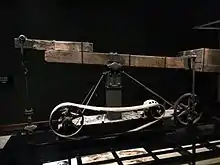| Founded | 1954 |
|---|---|
| Founder | William Myron Keck |
| Focus | supporting scientific, engineering, and medical research |
| Location |
|
Area served | United States |
| Website | www.wmkeck.org |



.jpg.webp)
The W. M. Keck Foundation is an American charitable foundation supporting scientific, engineering, and medical research in the United States. It was founded in 1954 by William Myron Keck, founder and president of Superior Oil Company (now part of ExxonMobil). The Foundation's net assets exceeded $1.3 billion at the end of 2019.
Overview
From its founding until his death in 1964, the Foundation was led by William Myron Keck. From 1964 to 1995, it was led by W. M. Keck's son, Howard B. Keck. Robert Addison Day, W. M. Keck's grandson has been chairman and president since 1996.
The Foundation provides grants in five broad areas: science and engineering research, undergraduate science and engineering, medical research, liberal arts, in Southern California. Some of the more notable projects that have received funding from the Keck Foundation include:
- 2017: The Keck Center for Science and Engineering,[1] at Chapman University, $21 million
- The W. M. Keck Center for Language Study[2] at Colgate University
- The Keck Center for International and Strategic Studies of Claremont McKenna College (the alma mater of Robert Addison Day, William Myron Keck's grandson, and chairman and president of W. M. Keck Foundation)
- The W.M. Keck Science Department of Claremont McKenna College, Pitzer College, and Scripps College.
- The W.M. Keck Center for Interdisciplinary Bioscience Training at Rice University in Houston, Texas (training arm of the Gulf Coast Consortia (GCC))[3]
- Support for building of the Keck Observatory at Pacific Lutheran University in Tacoma, Washington
- 1985, 1991: Construction of the W. M. Keck Observatory at Mauna Kea Observatory in Hawaii, Keck I, Keck II, about $70 million for each
- Keck Institute for Space Studies, established in 2008, a joint institute of the California Institute of Technology and the Jet Propulsion Laboratory
- 1999: Expansion of the Keck School of Medicine at the University of Southern California in Los Angeles, California, $110 million[4]
- The W.M. Keck Building Center for fMRI & the W.M. Keck Foundation Center for Ocean-Atmosphere Research at the University of California, San Diego
- Creation of the Keck Graduate Institute of Applied Life Sciences in Claremont, California
- Sponsor of the Keck Computer Science Lab at Loyola Marymount University in Los Angeles, California
- The W.M. Keck Center for Accelerator Mass Spectrometry at University of California, Irvine
- The WM Keck Center for 3D Innovation at University of Texas at El Paso[5]
- The William M. Keck Building at the California Institute of Technology
- The Peter G. Peterson Institute for International Economics in Washington D.C.
- The Keck Science Center at Pepperdine University[6]
- The Keck Array, part of the BICEP experiment (Background Imaging of Cosmic Extragalactic Polarization) at the South Pole observatory.
- W.M. Keck Earth Science and Metal Engineering Museum at the Mackay School of Earth Sciences and Engineering, whose renovation the foundation funded, at the University of Nevada, Reno
- The Keck Theater at Occidental College[7]
The Keck Foundation has been a long-time supporter of public television in Southern California, including underwriting the broadcast of Sesame Street on KCET since the 1970s.
Funding
The foundation has a maximum grant of $5 million, though funding is typically $2 million or less.
The W. M. Keck foundation has these requirements for funding:
- Research that is high impact and that questions or challenges the prevailing paradigm[8]
- Research projects that no one else is pursuing[8]
- A new research project that is in its early stages[8]
- Basic research, not translational or clinical research[8]
- Research that would result in general information and new methodologies that can be of benefit to the field, even if the project were to go awry[8]
- Research projects that are not funded by any other foundation, and research projects that could not move along without Keck funding[8]
- Though this is not a requirement, the W.M. Keck Foundation prefers projects that involve some kind of collaboration over single investigator research[8]
See also
- Robert Addison Day - current chairman and president (also a grandson of William Myron Keck)
- List of wealthiest charitable foundations
References
- ↑ "Chapman receives largest Orange County gift from W. M. Keck Foundation". Happenings. Retrieved 2017-09-28.
- ↑ "The Keck Center in Lawrence Hall is a high-tech space for the exploration of language and culture, promoting global perspectives in education". Happenings. Retrieved 2022-07-21.
- ↑ "ABOUT THE GULF COAST CONSORTIA". Archived from the original on October 4, 2013. Retrieved September 30, 2013.
In 2001 the GCC was created with a $3.5M gift from the W. M. Keck Foundation to foster collaborative research and training. [...] The GCC is composed of a training arm, the Keck Center for Quantitative Biomedical Bioscience Training, and a research arm, [...]
- ↑ "Keck School History". usc.edu. Retrieved 2017-05-22.
- ↑ "WM Keck Center for 3D Innovation". utep.edu. Retrieved 2017-05-22.
- ↑ "Pepperdine University Annual Report 2002". www.pepperdine.edu. Archived from the original on 2003-04-19.
- ↑ "Keck Theater". Oxy.edu. Occidental College. Retrieved 3 January 2024.
- 1 2 3 4 5 6 7 "W.M. Keck Foundation Research Program" (PDF). foundations.mit.edu. 20 May 2014. Archived from the original (PDF) on 2014-06-06. Retrieved 6 June 2014.